By Leen Randell
Updated: Jul 04, 2024
10 Best Herbal Decoctions For Dermatitis
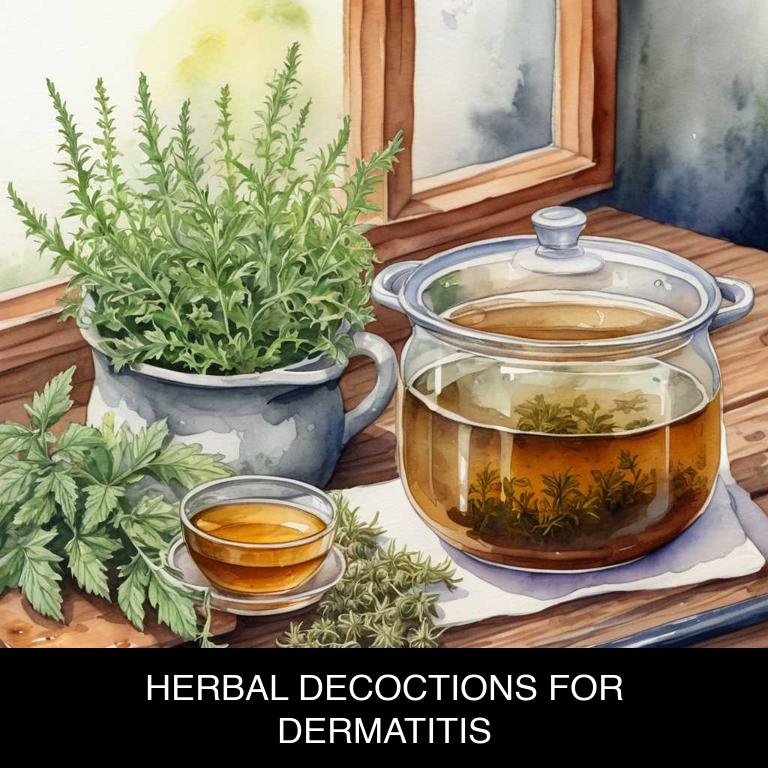
Herbal decoctions for dermatitis are a natural and effective way to alleviate symptoms of skin irritation, redness, and itching associated with this chronic condition.
By steeping herbs in hot water, a concentrated liquid is created that can be applied topically or ingested to soothe and calm the skin. Decoctions made from herbs like calendula, chamomile, and oatmeal have anti-inflammatory properties that help reduce swelling and promote healing, while others like turmeric and ginger possess antibacterial qualities that combat infection.
These herbal remedies can significantly improve quality of life for those suffering from dermatitis, providing relief from constant itching and discomfort, allowing individuals to enjoy normal daily activities without the burden of painful skin conditions.
The following article describes in detail the most important decoctions for dermatitis, including medicinal properties, parts of herbs to use, and recipes for preparations.
- 1. Urtica dioica
- 2. Calendula officinalis
- 3. Echinacea angustifolia
- 4. Hypericum perforatum
- 5. Taraxacum officinale
- 6. Matricaria chamomilla
- 7. Symphytum officinale
- 8. Tilia platyphyllos
- 9. Gaultheria procumbens
- 10. Baptisia tinctoria
- What is the best combination of herbal decoctions to use for dermatitis?
- What ailments similar to dermatitis are treated with herbal decoctions?
1. Urtica dioica
Stinging nettle decoctions helps with dermatitis because they possess anti-inflammatory properties that soothe and calm irritated skin.
The decoction's rich supply of antioxidants and flavonoids work together to reduce redness, swelling, and itching associated with dermatitis. Additionally, the natural astringent properties of stinging nettle help to reduce inflammation and tighten the skin, promoting a clearer and more even complexion.
As a result, stinging nettle decoctions provide effective relief from the discomfort and distress caused by dermatitis.
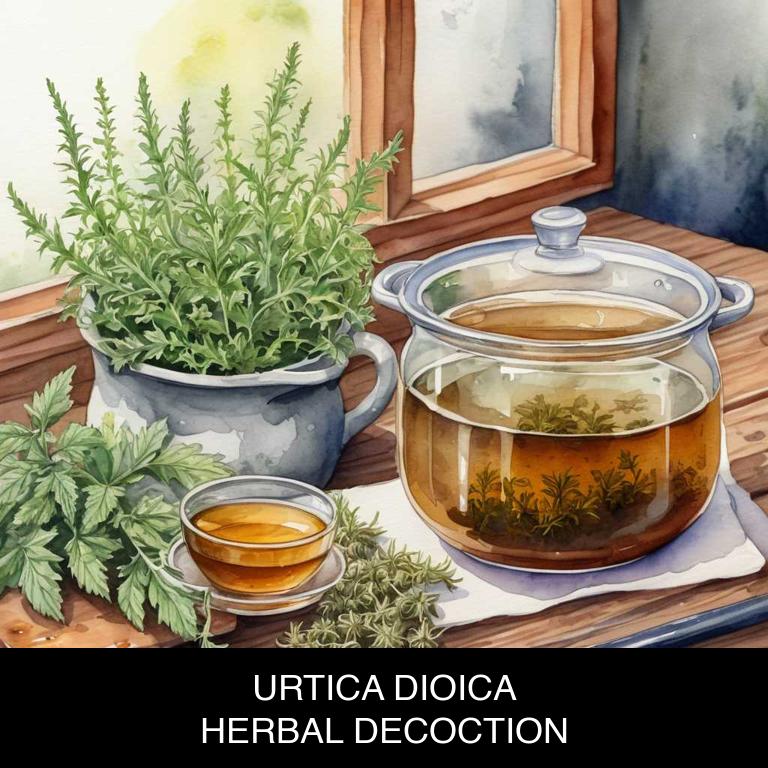
Medicinal Constituents
The list below shows the primary medicinal constituents in Urtica dioica decoctions that help with dermatitis.
- Quercetin: A flavonoid antioxidant that helps reduce inflammation and oxidative stress associated with dermatitis, thereby soothing skin irritations.
- Ursolic acid: A triterpenoid with anti-inflammatory and antioxidant properties that helps alleviate symptoms of dermatitis, such as redness, itching, and swelling.
- Polysaccharides: Complex carbohydrates with anti-inflammatory and soothing effects that help to calm irritated skin, reduce inflammation, and promote wound healing in dermatitis.
Parts Used
The list below shows the primary parts of stinging nettle used to make decoctions for dermatitis.
- Leaves: The leaves are one of the most commonly used parts due to their high content of urtic acid and other bioactive compounds.
- Roots: The roots of Urtica dioica are valued for their anti-inflammatory properties, making them a popular choice for treating skin conditions like dermatitis.
- Stems: The stems of the plant are also used, as they contain similar bioactive compounds to the leaves, contributing to their therapeutic properties.
Quick Recipe
The following recipe gives a procedure to make a basic stinging nettle for dermatitis.
- Harvest fresh leaves and stems of urtica dioica plant in the morning after dew has evaporated.
- Chop 2 tablespoons of fresh urtica dioica material into small pieces to release its medicinal properties.
- Combine chopped urtica dioica with 4 cups of boiling water in a saucepan to create decoction.
- Simmer the mixture for 5-7 minutes over low heat to allow active compounds to infuse.
- Strain the decoction using cheesecloth or a fine-mesh sieve to remove solids and discard solids.
2. Calendula officinalis
Pot marigold decoctions helps with dermatitis because of its potent anti-inflammatory and antioxidant properties.
The flavonoids and terpenes present in calendula, the herb used to make pot marigold decoctions, have been shown to reduce inflammation and itching associated with dermatitis. Additionally, the decoction's ability to soothe and moisturize the skin helps to repair damaged tissue and promote healing, alleviating symptoms such as redness, swelling, and discomfort.
As a result, pot marigold decoctions can provide effective relief from the uncomfortable and debilitating effects of dermatitis.

Medicinal Constituents
The list below shows the primary medicinal constituents in Calendula officinalis decoctions that help with dermatitis.
- Neryl acetate: This sesquiterpene helps reduce inflammation and promotes wound healing, making it beneficial for soothing skin irritations and dermatitis.
- Quercetin: A flavonoid phenolic compound, quercetin has potent anti-inflammatory and antioxidant properties that help calm and protect the skin, reducing redness and discomfort associated with dermatitis.
- Beta-sitosterol: A phytosterol with anti-inflammatory and immunomodulatory effects, beta-sitosterol may help regulate the immune response and reduce the severity of dermatitis symptoms.
Parts Used
The list below shows the primary parts of pot marigold used to make decoctions for dermatitis.
- Flowers: They are the most commonly used part due to their high concentration of bioactive compounds and anti-inflammatory properties.
- Leaves: They are used in decoctions for their antimicrobial and anti-inflammatory properties, which help soothe and calm dermatitis.
- Stems: They contain flavonoids and terpenoids that contribute to their anti-inflammatory and antioxidant properties, making them useful in treating dermatitis.
Quick Recipe
The following recipe gives a procedure to make a basic pot marigold for dermatitis.
- Harvest 20-30 fresh calendula flowers in the morning when petals are fully open.
- Rinse the flowers thoroughly with distilled water to remove dirt and impurities.
- Combine 1 tablespoon of the fresh flowers with 1 cup of boiling water in a saucepan.
- Steep the mixture for 5-10 minutes and then strain the liquid through a cheesecloth.
- Store the decoction in a dark glass bottle and refrigerate for up to 3 days.
3. Echinacea angustifolia
Kansas coneflower decoctions helps with dermatitis because of its unique combination of anti-inflammatory, antioxidant, and antimicrobial properties.
The decoction's flavonoids and triterpenoids have been shown to reduce inflammation and itching associated with skin conditions, while its saponins help to soothe and calm irritated skin. Additionally, the antibacterial and antifungal properties of the decoction work together to combat any underlying infections that may be contributing to the dermatitis.
As a result, Kansas coneflower decoctions provide natural relief from symptoms of dermatitis, promoting healthy and balanced skin.
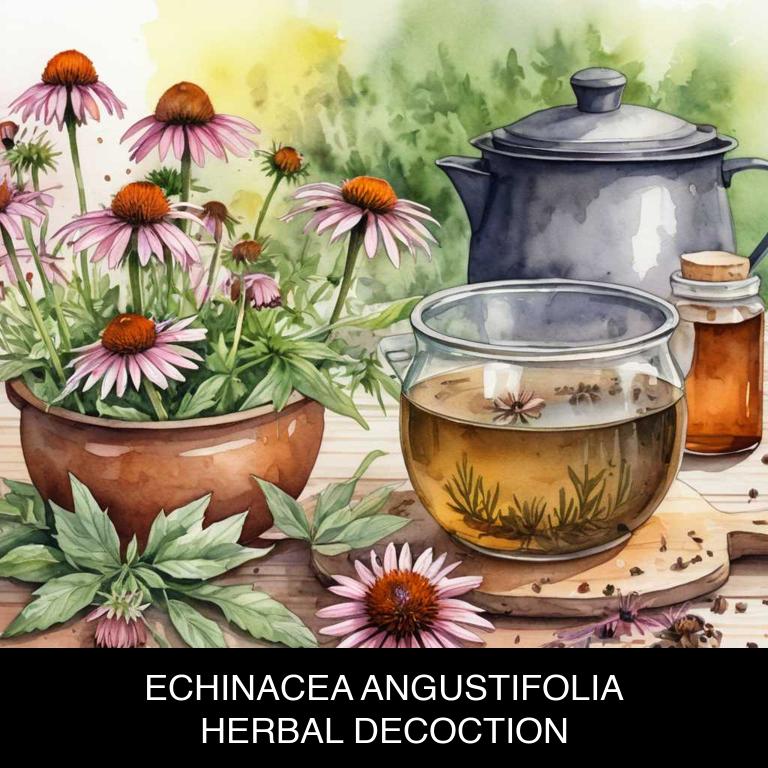
Medicinal Constituents
The list below shows the primary medicinal constituents in Echinacea angustifolia decoctions that help with dermatitis.
- Iridoid glycosides: These compounds have anti-inflammatory properties, which can help reduce redness and swelling associated with dermatitis.
- Alkaloids: Alkaloids in Echinacea angustifolia may exhibit immunomodulatory effects, helping to regulate the immune response and alleviate symptoms of dermatitis.
- Triterpenoids: Triterpenoids in this plant may possess antioxidant and anti-inflammatory properties, which can help protect the skin from damage and reduce inflammation associated with dermatitis.
Parts Used
The list below shows the primary parts of kansas coneflower used to make decoctions for dermatitis.
- Roots: They are the most commonly used part due to their high concentration of echinacoside, a compound believed to have anti-inflammatory properties.
- Rhyzomes: They are used for their similar chemical composition to roots, providing similar benefits in treating dermatitis.
- Leaves: They are used as a secondary option, containing some of the same compounds as the roots, although in lower concentrations.
Quick Recipe
The following recipe gives a procedure to make a basic kansas coneflower for dermatitis.
- Harvest the echinacea angustifolia roots in late fall or early spring when the plant is dormant for maximum potency.
- Dry the harvested roots in a low-temperature oven at 150 degrees fahrenheit for 2 hours to remove moisture.
- Grind the dried echinacea angustifolia roots into a fine powder using a mortar and pestle to increase surface area.
- Combine one teaspoon of the ground echinacea angustifolia powder with one cup of boiling water to create a decoction.
- Steep the mixture for 10 to 15 minutes to allow the active compounds to infuse into the water.
4. Hypericum perforatum
St John's wort decoctions helps with dermatitis because it exhibits anti-inflammatory and antioxidant properties that soothe and calm irritated skin.
The decoction's flavonoids and phenolic acids work to reduce redness, swelling, and itching associated with dermatitis, while its antihistamine-like effects help alleviate allergic reactions.
Additionally, St John's wort's antimicrobial properties combat bacterial and fungal infections that can exacerbate dermatitis symptoms, promoting healthy skin and a reduction in inflammation.
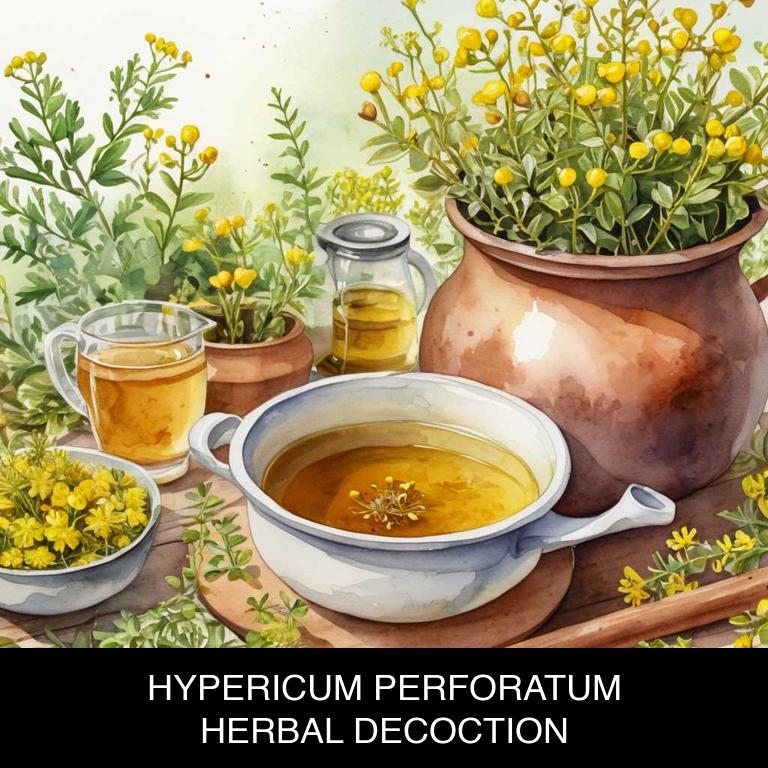
Medicinal Constituents
The list below shows the primary medicinal constituents in Hypericum perforatum decoctions that help with dermatitis.
- Hyperforin: Hyperforin is a phenolic compound that helps reduce inflammation and itching associated with dermatitis by inhibiting the release of pro-inflammatory mediators.
- Emodin: Emodin is a anthraquinone glycoside with anti-inflammatory and antipruritic properties that help alleviate dermatitis symptoms by reducing inflammation and itching.
- Quercetin: Quercetin is a flavonoid with potent anti-inflammatory and antioxidant properties that helps protect the skin from oxidative stress and inflammation, thereby alleviating dermatitis symptoms.
Parts Used
The list below shows the primary parts of st john's wort used to make decoctions for dermatitis.
- Leaves: The leaves are the most commonly used part due to their high concentration of hypericin, a compound that has anti-inflammatory and antimicrobial properties, helping to soothe and calm skin irritations.
- Flowers: The flowers are also frequently used for their antiseptic and anti-inflammatory properties, which can help to reduce redness and promote wound healing in dermatitis cases.
- Stems: The stems of Hypericum perforatum are sometimes used in decoctions for their ability to reduce inflammation and promote tissue repair, making them a useful addition to dermatitis treatments.
Quick Recipe
The following recipe gives a procedure to make a basic st john's wort for dermatitis.
- Harvest 1 part of fresh flowers and leaves from a healthy plant on a dry morning after dew has evaporated.
- Dry the harvested plant material in a low-temperature oven at 150 degrees fahrenheit for 2 hours.
- Grind 2 teaspoons of dried plant material into a fine powder using a mortar and pestle.
- Combine the powdered plant material with 1 cup of boiling water in a heat-resistant glass cup.
- Steep the mixture for 10-15 minutes then strain it through a cheesecloth into a cup.
5. Taraxacum officinale
Dandelion decoctions helps with dermatitis because it is rich in antioxidants, anti-inflammatory compounds, and vitamins A, C, and E. The decoction's bioactive components work together to reduce inflammation, soothe itchiness, and calm skin irritation.
Dandelion also has natural antibacterial properties that help combat bacterial overgrowth on the skin, often a contributing factor to dermatitis flare-ups.
By drinking dandelion tea or applying it topically, individuals with dermatitis can experience relief from symptoms and promote healthy skin regeneration.

Medicinal Constituents
The list below shows the primary medicinal constituents in Taraxacum officinale decoctions that help with dermatitis.
- Taraxasterol: This triterpene helps reduce inflammation and modulate the immune system, which can alleviate symptoms of dermatitis.
- Kaempferol: This flavonoid has anti-inflammatory and antioxidant properties, which can help soothe and protect the skin from further irritation and damage caused by dermatitis.
- Quercetin: This flavonoid has potent anti-inflammatory and antioxidant properties, which can help reduce swelling, redness, and itching associated with dermatitis, promoting faster healing and skin recovery.
Parts Used
The list below shows the primary parts of dandelion used to make decoctions for dermatitis.
- Leaves: Used for their anti-inflammatory properties to soothe skin irritations.
- Roots: Utilized for their diuretic and anti-inflammatory effects to help reduce skin inflammation and promote healing.
- Flowers: Employed for their anti-inflammatory and antimicrobial properties to calm and protect the skin from infections and irritations.
Quick Recipe
The following recipe gives a procedure to make a basic dandelion for dermatitis.
- Harvest 100g of taraxacum officinale roots and clean them thoroughly with cold running water.
- Chop the cleaned roots into smaller pieces and soak them in 1l of cold water for 2 hours.
- Bring the soaked mixture to a boil and then reduce the heat to a simmer for 30 minutes.
- Strain the decoction through a cheesecloth into a clean container discarding the solids.
- Store the decoction in a cool dark place and use it within 3 days after preparation.
6. Matricaria chamomilla
Chamomile decoctions helps with dermatitis because of its potent anti-inflammatory and soothing properties.
The flavonoids and terpenoids present in chamomile calm down itchy skin, reduce redness and swelling, and ease discomfort associated with eczema and other inflammatory skin conditions. Additionally, chamomile's antimicrobial properties help to prevent infection and promote wound healing, further reducing the risk of complications.
As a natural remedy, chamomile decoctions offer an effective and gentle approach to managing dermatitis symptoms.
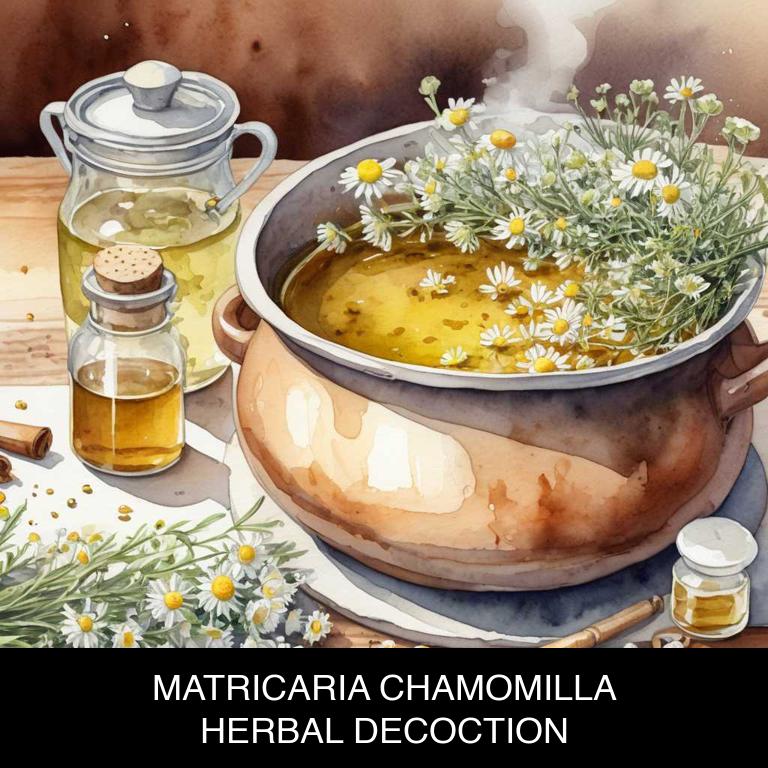
Medicinal Constituents
The list below shows the primary medicinal constituents in Matricaria chamomilla decoctions that help with dermatitis.
- Apigenin: This flavonoid helps with dermatitis by acting as an anti-inflammatory agent, reducing redness and swelling associated with skin conditions.
- Luteolin: This flavonoid has potent antioxidant and anti-inflammatory properties, which help soothe and calm irritated skin, reducing the severity of dermatitis symptoms.
- Α-bisabolol: This sesquiterpene has anti-inflammatory and antimicrobial properties, which help to reduce skin inflammation and prevent infections that can exacerbate dermatitis.
Parts Used
The list below shows the primary parts of chamomile used to make decoctions for dermatitis.
- Flowers: They are the most used part of Matricaria chamomilla due to their high concentration of apigenin and luteolin, which are known for their anti-inflammatory properties.
- Leaves: Leaves are also used in decoctions for dermatitis due to their antioxidant and soothing effects.
- Roots: The roots of Matricaria chamomilla are used to treat skin conditions like dermatitis due to their anti-inflammatory and antiseptic properties.
Quick Recipe
The following recipe gives a procedure to make a basic chamomile for dermatitis.
- Harvest dried flowers of matricaria chamomilla at a ratio of 1 part herb to 250ml water for decoctions.
- Dry the flowers further if they are damp or moist to prevent mold growth in storage.
- Combine the dried flowers with boiling water in a saucepan or teapot to start infusion.
- Steep the mixture for 5-10 minutes to allow the herbal properties to infuse in the water.
- Strain the decoction through a cheesecloth or fine-mesh sieve into a cup for consumption.
7. Symphytum officinale
Comfrey decoctions helps with dermatitis because of its potent anti-inflammatory properties, which soothe irritated skin and reduce redness and swelling.
The allantoin present in comfrey also promotes wound healing by stimulating collagen synthesis, promoting tissue regeneration, and improving skin elasticity. Additionally, comfrey's antimicrobial activity helps to prevent infection and accelerate the recovery process.
As a result, comfrey decoctions can provide effective relief from dermatitis symptoms, helping to calm and soothe affected areas and promote healthy skin.
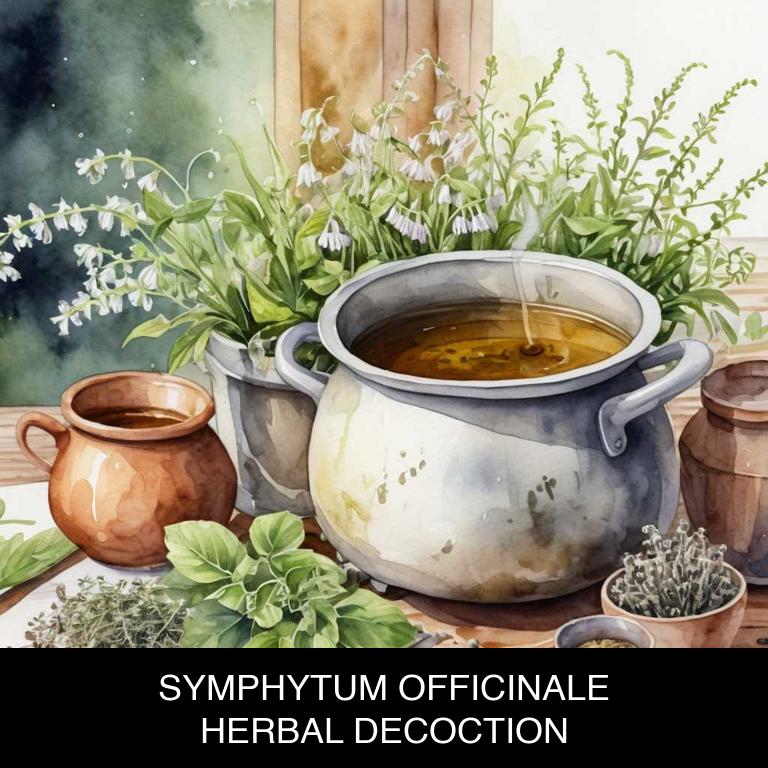
Medicinal Constituents
The list below shows the primary medicinal constituents in Symphytum officinale decoctions that help with dermatitis.
- Allantoin: Allantoin is a naturally occurring compound that helps to promote wound healing, reduce inflammation, and soothe skin irritations associated with dermatitis.
- Asparagine: Asparagine is an amino acid that has anti-inflammatory properties, which can help to reduce redness, itching, and swelling caused by dermatitis.
- Saponins: Saponins are a group of compounds that exhibit anti-inflammatory and antimicrobial properties, which can help to alleviate skin symptoms of dermatitis and prevent infections.
Parts Used
The list below shows the primary parts of comfrey used to make decoctions for dermatitis.
- Roots: The roots of Symphytum officinale are used to make decoctions for dermatitis because they contain high levels of allantoin, which helps to soothe and heal skin irritations.
- Leaves: The leaves of Symphytum officinale are used to make decoctions for dermatitis because they possess anti-inflammatory and antiseptic properties, which aid in reducing skin inflammation and preventing infection.
- Stems: The stems of Symphytum officinale are used to make decoctions for dermatitis because they contain bioactive compounds that help to reduce inflammation and promote skin healing.
Quick Recipe
The following recipe gives a procedure to make a basic comfrey for dermatitis.
- Harvest 10-20 grams of symphytum officinale root and clean it thoroughly with lukewarm water.
- Chop the cleaned symphytum officinale root into small pieces to increase its surface area for infusion.
- Combine the chopped root with 250ml of boiling water and let it steep for 10-15 minutes.
- Strain the mixture through a cheesecloth or a fine-mesh sieve to remove the plant material completely.
- Allow the decoction to cool down and store it in a sealed container in the refrigerator for later use.
8. Tilia platyphyllos
Broad-leaved lime decoctions helps with dermatitis because of its potent anti-inflammatory and antioxidant properties.
The decoction's flavonoids and phenolic acids work together to reduce inflammation, itching, and redness associated with skin conditions such as eczema and psoriasis. Additionally, the decoction's antimicrobial properties help combat bacterial and fungal infections that can exacerbate dermatitis symptoms.
As a natural remedy, broad-leaved lime decoctions offer a gentle and non-invasive way to soothe and calm the skin, promoting overall skin health and well-being.
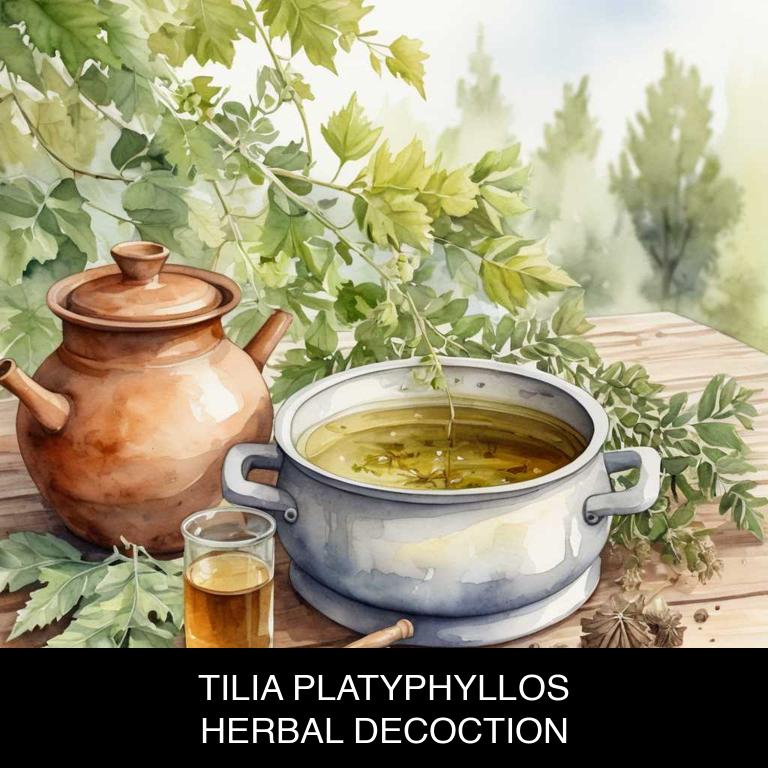
Medicinal Constituents
The list below shows the primary medicinal constituents in Tilia platyphyllos decoctions that help with dermatitis.
- Flavonoids: These compounds, particularly quercetin, exhibit anti-inflammatory and antioxidant properties, which can help soothe and calm skin irritations associated with dermatitis.
- Triterpenoids: Tilia platyphyllos contains various triterpenoids, such as ursolic acid, which have been shown to possess anti-inflammatory and antimicrobial activities, potentially aiding in the relief of dermatitis symptoms.
- Phenolic acids: These compounds have been found to possess anti-inflammatory and antimicrobial properties, which can help reduce inflammation and prevent infection in dermatitis-prone skin.
Parts Used
The list below shows the primary parts of broad-leaved lime used to make decoctions for dermatitis.
- Leaves: They are used to make decoctions for dermatitis because of their anti-inflammatory and soothing properties.
- Buds: They are used to make decoctions for dermatitis because of their anti-inflammatory and antiseptic properties that can help soothe skin irritations.
- Barks: They are used to make decoctions for dermatitis because of their astringent and anti-inflammatory properties that can help reduce skin inflammation.
Quick Recipe
The following recipe gives a procedure to make a basic broad-leaved lime for dermatitis.
- Harvest 20-30 grams of fresh tilia platyphyllos leaves in early morning for optimal potency retention.
- Chop the leaves into small pieces using a sharp knife to increase their surface area.
- Combine the chopped leaves with 1 liter of boiling water in a saucepan to create a decoction.
- Simmer the mixture for 10-15 minutes or until the liquid has reduced to 500 milliliters.
- Strain the decoction through a cheesecloth or a fine-mesh sieve into a clean glass container.
9. Gaultheria procumbens
Wintergreen decoctions helps with dermatitis because of its potent anti-inflammatory and antiseptic properties.
The decoction's high concentration of methyl salicylate and other bioactive compounds soothes itchy skin, reduces redness and swelling, and inhibits the growth of bacteria that can exacerbate inflammation. Additionally, wintergreen's antioxidant properties help protect the skin from damage caused by free radicals, promoting healing and reducing the risk of further irritation or infection.
This natural remedy provides a gentle yet effective treatment for dermatitis, allowing skin to recover and regain its healthy state.
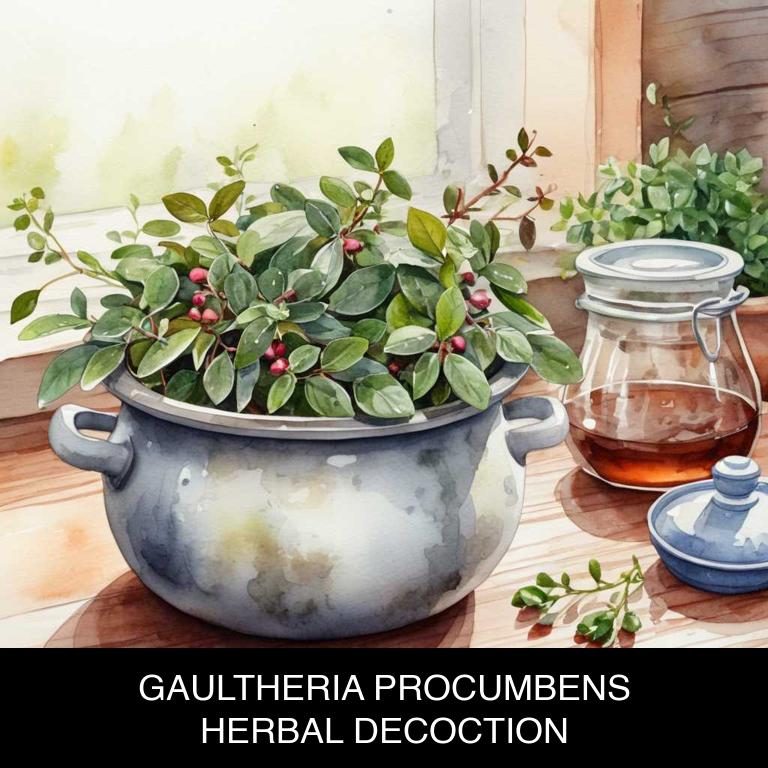
Medicinal Constituents
The list below shows the primary medicinal constituents in Gaultheria procumbens decoctions that help with dermatitis.
- Gentiopicrin: A sesquiterpene glycoside found in Gaultheria procumbens, gentiopicrin has anti-inflammatory and antipruritic properties that help alleviate itching and inflammation associated with dermatitis.
- Gaultherin: A sesquiterpene glycoside, gaultherin has been shown to exhibit antioxidant and anti-inflammatory activities that contribute to its potential in soothing skin irritations and reducing inflammation in dermatitis.
Parts Used
The list below shows the primary parts of wintergreen used to make decoctions for dermatitis.
- Leaves: The leaves are the most used part due to their high concentration of salicylic acid and other compounds that help reduce inflammation and itching associated with dermatitis.
- Roots: The roots are used because they contain a higher concentration of phenolic compounds, which have antiseptic and anti-inflammatory properties that aid in soothing and treating dermatitis.
- Stems: The stems are also used due to their content of salicylic acid and other compounds that help to reduce inflammation, itching, and redness associated with dermatitis.
Quick Recipe
The following recipe gives a procedure to make a basic wintergreen for dermatitis.
- Harvest fresh gaultheria procumbens leaves and stems according to a ratio of one part plant material to two parts water.
- Combine the gaultheria procumbens plant material with 2 cups of water in a saucepan and heat to a boil.
- Reduce the heat to a simmer and let the mixture steep for 10 to 15 minutes or until the liquid has reduced slightly.
- Strain the decoction through a cheesecloth or a fine-mesh sieve into a clean bowl to remove the solids.
- Store the decoction in the refrigerator for up to 24 hours and consume it chilled or at room temperature.
10. Baptisia tinctoria
Wild indigo decoctions helps with dermatitis because of its potent antibacterial, anti-inflammatory, and antiseptic properties.
The decoction's active compounds, such as berberine and isothiocyanates, have been shown to reduce inflammation, alleviate itching and redness, and combat bacterial infections that can exacerbate skin conditions like eczema and dermatitis. Additionally, the decoction's astringent properties help to soothe and calm irritated skin, promoting a healthy and balanced skin microbiome.
By addressing these underlying causes, wild indigo decoctions offer a natural and effective solution for managing dermatitis symptoms.
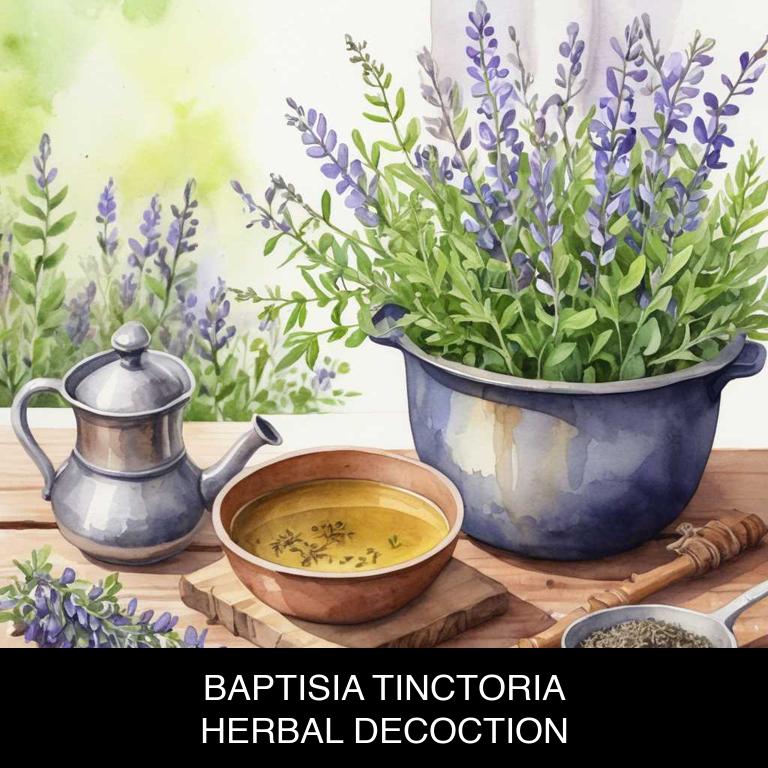
Medicinal Constituents
The list below shows the primary medicinal constituents in Baptisia tinctoria decoctions that help with dermatitis.
- Isoflavones: These isoflavones have anti-inflammatory and antioxidant properties that help reduce skin inflammation and prevent tissue damage associated with dermatitis.
- Flavonoids: These flavonoids exhibit potent anti-inflammatory and antioxidant activities, which can help alleviate symptoms of dermatitis, such as redness, itching, and swelling.
- Alkaloids: Baptifolin has been shown to possess anti-inflammatory and immunomodulatory properties, helping to regulate the immune response and reduce inflammation in skin conditions like dermatitis.
Parts Used
The list below shows the primary parts of wild indigo used to make decoctions for dermatitis.
- Roots: They are used due to their high concentration of alkaloids and glycosides, which have anti-inflammatory and soothing properties beneficial for skin conditions.
- Leaves: They are used because of their rich content of flavonoids and other compounds that help reduce inflammation and promote skin healing.
- Buds: They are used due to their high concentration of essential oils and other bioactive compounds that possess anti-inflammatory and antiseptic properties, making them effective in treating skin irritations.
Quick Recipe
The following recipe gives a procedure to make a basic wild indigo for dermatitis.
- Harvest fresh baptisia tinctoria roots in the fall after the foliage has died back for maximum potency.
- Clean and dry the harvested roots to prevent contamination and ensure proper infusion.
- Crush 1 ounce of dried baptisia tinctoria root into a fine powder using a mortar and pestle.
- Combine the powder with 2 quarts of boiling water in a large pot to create the decoction.
- Simmer the decoction for 10 to 15 minutes to allow the active compounds to infuse into the water.
What is the best combination of herbal decoctions to use for dermatitis?
The best combination of herbal decoctions that help with dermatitis is a blend of calendula, aloe vera, and chamomile.
Calendula's anti-inflammatory and antiseptic properties soothe and calm irritated skin, while aloe vera's moisturizing properties help to hydrate and soften the skin. Chamomile, with its anti-inflammatory and antioxidant properties, further reduces redness and promotes healing. These three herbs work synergistically to provide relief from the symptoms of dermatitis, promoting healthy and clear skin.
This combination can be brewed as a tea or applied topically as a compress.
What ailments similar to dermatitis are treated with herbal decoctions?
Ailments similar to dermatitis/decoctions.html">dermatitis/decoctions.html">dermatitis that are treated with herbal decoctions are eczema, psoriasis, and acne.
Herbs like turmeric, neem, and aloe vera are commonly used in decoctions to soothe and calm irritated skin, reducing inflammation and promoting healing. Other herbs like tea tree oil, chamomile, and calendula are also effective in treating skin conditions such as rashes, redness, and itching.
These natural remedies can provide relief from symptoms without harsh chemicals or side effects.